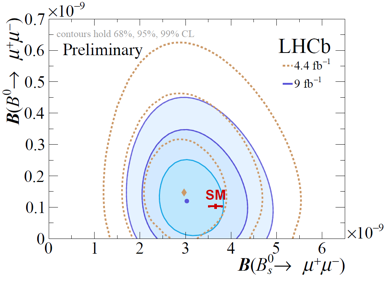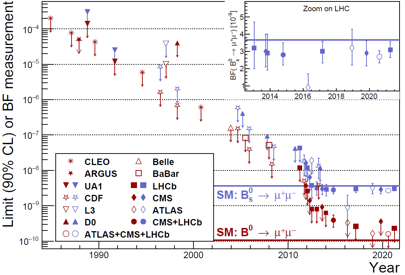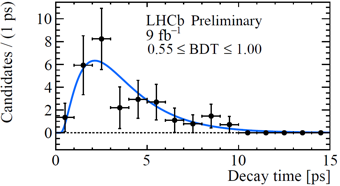[ Branching fraction Bs0→μ+μ– = (3.09+0.46-0.43+0.15-0.11)x10-9 ; B0→μ+μ– < 2.6×10-10 ]
Today, at the Rencontres de Moriond EW and at the CERN seminar, the LHCb collaboration presented an improved measurement of the very rare Bs0→ μ+μ– decay. The measured branching fraction (3.09+0.46-0.43+0.15-0.11)x10-9 is in agreement with the Standard Model (SM) prediction of (3.66±0.14)x10-9. It is the most precise single experiment measurement to date.

The full LHCb Run 1 and Run 2 data set was used to obtain this result. A special event selection (BDT for experts) was used to classify data into intervals with different ratios of Bs0→μ+μ– decays and background contributions. The μ+μ– invariant mass spectrum for the intervals with the smallest background contribution (BDT>0.5) is shown in the image above. The contribution of the Bs0→ μ+μ– decay is clearly visible with a statistical significance of 10 standard deviations (σ) at the Bs0 mass and is indicated as the red peaking function. The green peaking function at lower mass shows the contribution from the even rarer B0→ μ+μ– decay, whose SM rate is about 30 times smaller than that of the Bs0→ μ+μ– decay, however, the production of B0 is 4 times more abundant than that of Bs0. The size of this contribution (1.7σ) is not found to be significant, and so an upper limit is set for the decay at a value of 2.6×10-10. The other functions show the estimated contributions from background processes, but for the purple function, which represents the Bs0→μ+μ– events which lost some energy due to a photon radiated from the Bs0 valence quarks. These events, which are experimentally searched for the first time, are found to be compatible with zero within the measurement error, and this allowed to set an upper limit on the rate of Bs0→μ+μ–γ at a value of 2.0×10-9 (95% CL for experts) for μ+μ– mass above 4.9 GeV/c2. The left image shows a 2 dimensional representation of the branching fraction measurements for Bs0→ μ+μ– and B0→ μ+μ–. The SM Model value is shown as the red cross. The central value from today’s measurement is indicated with the blue dot. The blue contours show limits of regions with different statistical proximity (68%, 95% CL, etc., for experts), while the yellow contours indicate the previous, less constraining, measurement. These results are in perfect agreement with the SM prediction.
The probability, or branching fraction, of the Bs0 meson to decay into two oppositely charged muons is very small in the SM and is precisely calculated. On the other hand, a large class of theories that extend the SM, such as, for example, supersymmetry, allows significant modifications to this branching fraction and therefore an observation of any significant deviation from the SM prediction would reveal the influence of new physics. The decay of a Bs0 meson into a muon pair has therefore long been regarded as one of the most promising places to search for these new effects. This decay has been searched for more than 30 years by different experiments at different accelerators as seen in the image to the left. The LHCb collaboration obtained the first evidence, with a significance of 3.5σ, in November 2012 and, together with the CMS collaboration, the first observation, with a significance of 6.2σ, in May 2015. Moreover, in February 2017, LHCb announced the first single experiment observation, with a statistical significance of 7.8σ. Previous results already severely constrained the type of SM-extension models that are still allowed. The results announced today, with a statistical significance of 10σ and agreement with the SM, isolate even more precisely the parameter region in which these new models can exist, and therefore focuses future experimental searches and theoretical attention. All candidate models of physics beyond the SM will have to demonstrate their compatibility with this important result including models which propose explanation of hints for lepton universality anomalies, like RK, for which an update was also announced today.
Some new-physics models also allow the possibility of a different Bs0 “effective” lifetime from what is predicted in the SM. LHCb also reported today an improved measurement of this quantity, and found it to be 2.07±0.29±0.03 ps in agreement with the SM prediction. The figure to the left shows the distribution of the Bs0→μ+μ– decay time, along with the fit function used to measure the lifetime. This function is an exponential decay law, modified to account for the non-uniform detector efficiency.
Learn more in the LHCb Moriond presentation, in the LHCb CERN seminar and in the forthcoming LHCb paper.



